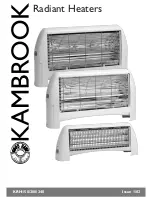
lp-441 Rev. 004 Rel. 000 Date 7.2.21
12
Products to Avoid
Areas Likely to Have
Contaminants
Spray cans containing fluorocarbons
Dry cleaning / laundry areas and
establishments
Permanent wave solutions
Swimming pools
Chlorinated waxes / cleaners
Metal fabrication plants
Chlorine-based swimming pool chem-
icals
Beauty shops
Calcium chloride used for thawing
Refrigeration repair shops
Sodium chloride used for water
softening
Photo processing plants
Refrigerant leaks
Auto body shops
Paint or varnish removers
Plastic manufacturing plants
Hydrochloric or Muriatic acid
Furniture refinishing areas and es-
tablishments
Cements and glues
New building construction
Antistatic fabric softeners used in
clothes dryers
Remodeling areas
Chlorine-type bleaches, laundry
detergents, and cleaning solvents
Garages and workshops
Adhesives used to fasten building
products
Table 3 - Products and Areas Likely to Have Contaminants
NOTE: DAMAGE TO THE HEATER CAUSED BY EXPOSURE TO
CORROSIVE VAPORS IS NOT COVERED BY WARRANTY.
(Refer to
the limited warranty for complete terms and conditions.)
H. Removing a Heater from a Common Vent System
Do not install the heater into a common vent with any other
appliance. This will cause flue gas spillage or appliance malfunction,
resulting in possible substantial property damage, severe personal
injury, or death.
Failure to follow all instructions can result in flue gas spillage and
carbon monoxide emissions, causing severe personal injury or death.
When removing an existing heater, follow the steps below.
1. Seal any unused openings in the common venting system.
2. Visually inspect the venting system for proper size and horizontal
pitch to determine if there is blockage, leakage, corrosion, or other
deficiencies that could cause an unsafe condition.
3. If practical, close all building doors, windows, and doors between the
space in which the water heater remains connected to the common
venting system and other spaces in the building. Turn on clothes
dryers and any appliances not connected to the common venting
system. Turn on any exhaust fans, such as range hoods and bathroom
exhausts, at maximum speed. Do not operate a summer exhaust fan.
Close all fireplace dampers.
4. Place in operation the appliance being inspected. Follow the lighting
instructions. Adjust the thermostat so the appliance will operate
continuously.
5. Test for spillage at the draft hood relief opening after 5 minutes of
main burner operation. Use the flame of a match or candle or smoke
from a cigarette.
6. After it has been determined that each appliance remaining
connected to the common venting system properly vents when tested
as outlined, return doors, windows, exhaust fans, fireplace dampers,
and any other gas burning appliances to their previous condition of
use.
Figure 2 - CO Warning Label
7. Any improper operation of the common venting system should
be corrected to conform to the National Fuel Gas Code, ANSI
Z223.1. When resizing any portion of the common venting system,
the system should approach the minimum size as determined using
the appropriate tables in Appendix G of ANSI Z223.1.
I. Anode Rod
This water heater may be equipped with an anode rod. Anode
rods are sacrificial components that counteract water chemistry to
minimize or eliminate tank corrosion.
The anode rod should be inspected annually and replaced as
necessary to prolong tank life. Have the supply water quality
professionally analyzed, as local water conditions will influence the
duration for inspection and replacement of the anode rod.
The use of a water softener may increase the speed of anode
consumption. More frequent inspection of the anode is needed
when using softened or treated water.
Water with high sulfate and/or mineral content can produce a rotten
egg odor in heated water. Consult a water treatment specialist for
potential remedies.
NOTE:
Failure of a heat exchanger due to lime scale build-up on the
heating surface, low pH, or other imbalance IS NOT covered by the
warranty.
NOTE:
Do not remove the anode rod from an operating water
heater. Operating the water heater without the anode rod will
shorten the life of the tank and VOID the warranty.
Hydrogen gas is produced in a hot water system served by this
heater that has not been used for a long period of time (two [2]
weeks or more). Hydrogen gas is extremely flammable. To reduce
the risk of injury under these conditions, it is recommended that
the hot water faucet be opened for several minutes at the kitchen
sink before using any electrical appliance connected to the hot
water system. When hydrogen is present, there will probably be
an unusual sound such as air escaping through the pipe as the
water begins to flow. There should be no smoking or open flame
near the faucet at the time it is open.













































